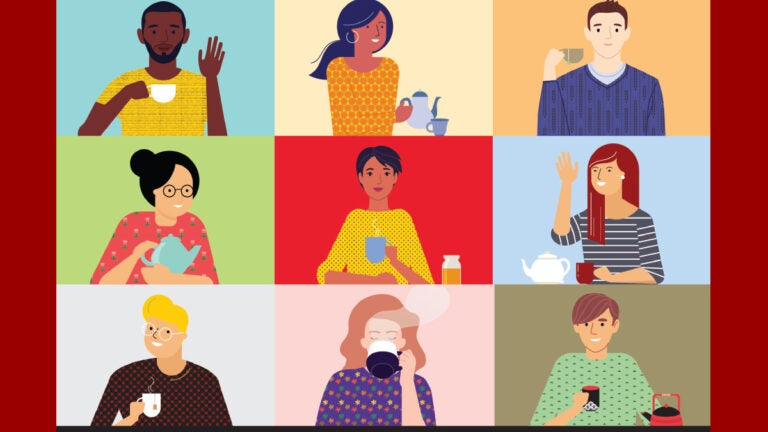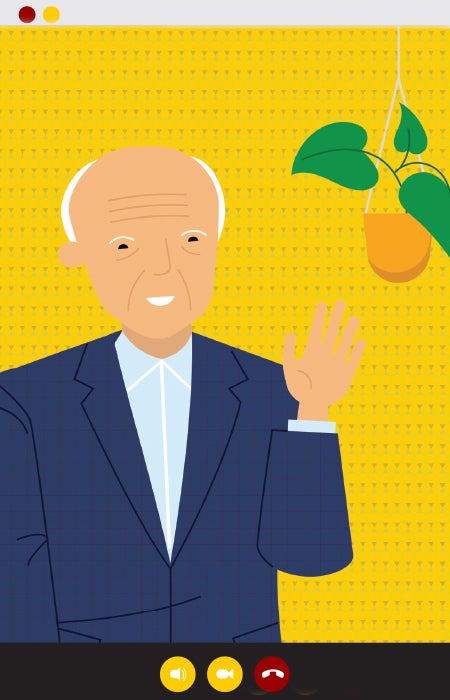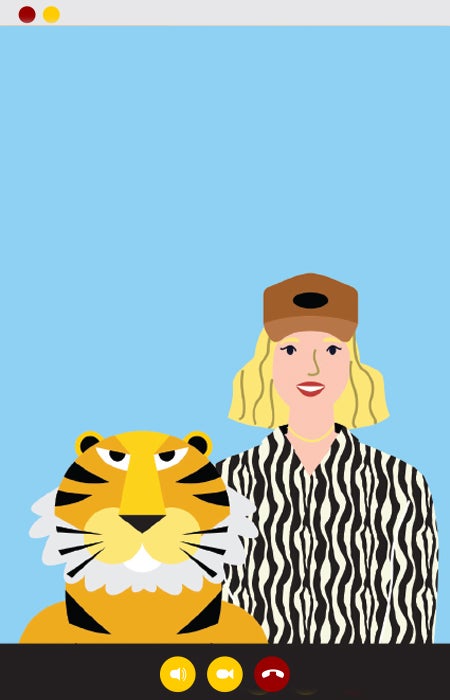
Create, Connect, Inspire — The Unexpected Value of Online Learning
If you could listen to a 95-year-old Holocaust survivor, compete for a license to perform on the Elizabethan stage during an outbreak of plague, virtually meet the authors of the books you’re studying or learn tips from a legendary Tahitian big-wave surfer, wouldn’t you leap at the chance? USC Dornsife students got the opportunity to do all this and more following the switch to online learning in the Spring semester.
It was exciting, engaging, inspirational and — perhaps surprisingly — a success.
However, there’s no point pretending otherwise: Switching all USC Dornsife courses online halfway through the Spring semester — as the pandemic threatened the safety of our students, faculty and staff on campus — was a challenge of Herculean scope.
That the College was able to achieve so much is thanks to the resourcefulness, perseverance and — above all — creativity of both USC Dornsife faculty and students who worked so hard to make the most of online learning. While on-campus education remains the gold standard for USC and its peer universities, the online experience nevertheless proved to be much more effective than many had expected, opening surprising new avenues through which to engage students.
Andrew Stott, college dean of undergraduate education and academic affairs and professor of English, credited USC Dornsife faculty, staff and administrators with doing “a great job.”
“In the space of three days, we took 3,500 courses online,” he says. What began as an emergency response moved to refining and improving teaching methods and then on to exploring the creative and innovative things possible through online learning, he added.
Given that at least some portion of teaching will remain online in the fall, the next step for USC Dornsife over the summer is to move beyond comfort with the technology to an even higher standard of academic excellence in online education.
To that end, Stott says USC Dornsife is investing in technology, software and tools to ensure this is a truly great experience for students. “We’ll be spending a great deal of time, attention and effort on making sure we’re ready for the fall, so students have academic continuity and the academic rigor they expect from a USC Dornsife education.”
In reflecting upon what we learned in the rapid transition, Stott observed that professors were able to enhance education in new and unexpected ways, and even provide benefits for students that differed from those of on-campus learning. For example, professors invited leading thinkers from outside the campus community and also built online collaborations that fostered new forms of innovation and creativity.
New Lessons Learned
“What the move to online has shown us is that we have a lot more flexibility in the way that we can enrich the educational experience than perhaps we realize,” Stott says.
While acknowledging that it’s painful to be away from campus, Stott argues that the lockdown requires us to be creative and flexible in new and innovative ways.
“We’ve really been able to leverage what it is about the USC Dornsife faculty and education that makes it so special,” he says. “It’s not the bricks and mortar — even though that’s important to us and important to our tradition. It’s the people, it’s the community and it’s the ideas, and that can also live online.”
Stott emphasizes the temporary nature of the current situation, however, reminding us that we all hope to return to on-campus learning as soon as it is safely possible.
“The important thing to remember in the meantime is that the spirit of USC Dornsife, and the spirit of the liberal arts, has always lived in the circulation of ideas.”
Afterall, Stott notes, books are the original “distance learning,” allowing us to commune with the minds of Aristotle, William Shakespeare, Frederick Douglass or Aphra Behn across centuries and continents.
As forthe Trojan Family, Stott notes it’s still very much alive and well.
“The idea of family has always contained this idea that we can be far apart, but still connected to one another,” he says. “We meet continually in virtual spaces and in terms of our shared endeavor and our shared commitment to our College and its traditions. Even though we’re far apart right now, we’ll be back again soon enough and this will seem like a dream.”

Meet the Experts
Among the benefits of online learning are the unprecedented opportunities to invite influential outside figures into the virtual classroom, enabling students to learn from the insights of experts beyond the USC community.
Stott notes that students at USC Dornsife are particularly privileged in this regard as the world-class faculty can help them connect with members of their own academic, intellectual and professional networks.
Sandra Ferrari Disner, associate professor (teaching) of linguistics, invited the world’s most renowned sociolinguist, William Labov, to “Zoom” into her “Language and Society” course.
Described by Linguistics Department Chair and Professor of Linguistics Andrew Simpson as “a living legend,” Labov was awarded the prestigious Talcott Parsons Prize by the American Academy of Arts and Sciences this year — only the 11th recipient since the prize was created in 1974. When the awards ceremony was postponed due to COVID-19, Labov offered to deliver his acceptance speech to Disner’s class instead.
“In addition to being a deep thinker, he’s a wonderful raconteur,”Disner said. “The experience was a real treat for our students.”
Students taking “Mexican Immigrants in Sociological Perspective,” a course taught by Florence Everline Professor of Sociology Pierrette Hondagneu-Sotelo, gained unique perspectives on their study materials when their professor invited the authors of the books they were reading into their Zoom classroom. “It was inspiring for the students — themselves mostly Latinx first-generation college students from working class families — to ask Latinx sociologists not only about their research, but how they had navigated higher education,” Hondagneu-Sotelo said. “This allowed them to imagine their own future educational possibilities.”
In a history research seminar on Jewish resistance during the Holocaust, students were able to hear first-hand from 95-year-old Holocaust survivor Zenon Neumark, who Zoomed into the class taught by Wolf Gruner, Shapell-Guerin Chair in Jewish Studies and professor of history.
“Zenon told the students how he managed to escape from several camps, joined three resistance groups and saved several fellow Jews in Nazi-occupied Poland,” Gruner said. “He left the class with this advice: ‘To fail is not a crime, but failing to try is.’”
Creativity Rules
In his course “English Literature to 1800: Stages of Power,” Stott created a “Reacting to the Past” game, set in 1592. Students divided into three teams to compete for a license to perform on the Elizabethan stage during an outbreak of plague. They experienced the business and politics of
Elizabethan drama in character and performed Shakespeare’s Richard III and Christopher Marlowe’s Doctor Faustus. They also wrote and presented a pageant in praise of Elizabeth I.
Students taking the general education seminar “Modern Russian Culture,” offered by the Slavic Languages and Literatures Department, also participated in a “gamified” simulation titled “Persecution in Putin-Era Russia.” First, they researched opponents to Russian President Vladimir Putin’s authoritarian practices who’ve been jailed or harassed, then presented their findings via wiki pages they created in the virtual learning environment, Blackboard. In the simulation, five dissidents were “arrested” each week. Working in teams, students read each other’s wiki pages to identify those imprisoned and to earn points to free them. The team with the most points — and fewest members in jail — at the end of the semester won.
How will the world rebuild after the pandemic? In his course “The Global South in World Politics,” USC Dornsife’s Douglas Becker, assistant professor (teaching) of international relations and environmental studies, teamed up with a colleague at South Korea’s Hankuk University of Foreign Studies to create a mock G20 summit.
“This was a great opportunity to use the online lecture format to bring two student populations together, enabling them to work together with partners from different cultural, educational and political backgrounds,” Becker said.
Students in Derek Grossman’s course “Introduction to Asian Security Affairs” participated in mock National Security Council briefings where they acted as policymakers who must brief President Donald Trump (played by Grossman) on issues throughout the Indo-Pacific, including India-Pakistan nuclear tensions, the South China Sea, Taiwan, North Korea and whether the president can “punish” China for “hiding” COVID-19.
“What the move to online has shown us is that we have a lot more flexibility in the way that we can enrich the educational experience than perhaps we realize.”“Mock presentations are a frequent teaching tool in international relations, and National Security Council briefings work well online because they are realistic in today’s environment,” says Grossman, adjunct professor of the practice of political science and international relations and a senior defense analyst at the Rand Corporation.
Doing More With Less
To teach her“Approaches to History” course on historical interpretation of evidence, including the uses of archives, Professor (Teaching) of History Deborah Harkness usually relies on materials from USC Libraries Special Collections. She overcame the challenge of accessing these on-campus resources in the second half of the semester by mailing her students letters and other documents that provided firsthand historical testimony or direct evidence. Harkness, the best-selling author of the All Souls Trilogy, sourced the materials on eBay, thus ensuring her students enjoyed the valuable experience of working with manuscript sources.
USC Dornsife’s French and Italian Department created a virtual honors-thesis showcase that brought faculty, students and families together to learn more about honors projects, like that of senior Rebecca Braganca, a French and global health double major. Braganca, who is exploring the invention of pediatrics in late 18th-century France, researched debates around vaccination, theories of bodily integrity and child development, and aesthetic representations of children in art and literature. Thanks to the online presentation of her honors thesis, she was able to share images, text and original sources with an extended audience that included members of her family.
Students in Professor of Italian, Comparative Literature and English Margaret Rosenthal’s general education course “Women Writers in Europe and America” took full advantage of online learning to deliver creative work.
Among them was Shana Busch, a freshman majoring in human biology. Busch analyzed 18th- and 19th-century literature by women through the lens of modern psychology principles and knowledge of cognitive development. By finding an innovative synergy between her major and literature, she was able to connect the latter to psychology, philosophy and medicine.
“I want to figure out what the actual effect of oppression and limited education was upon the cognitive development and mental state of women,” says Busch, who focused on Mary Wollstonecraft’s work and Kate Chopin’s novel The Awakening.
“What these students proposed is wonderfully inventive,” Rosenthal says. “Their projects are innovative and reach beyond what’s required in a G.E. class.”
Students in postdoctoral scholar and teaching fellow Rika Hiro’s art history course, “Later Japanese Art,” had planned to mount an exhibition in Doheny Library, showing their research on the USC Libraries’ rare collection of pre-World War II Japanese posters. When that was cancelled, Hiro, her enterprising students and their library partners moved the exhibition online, creating a unique digital resource for scholars.
“While our plans for having a physical exhibition were derailed by the COVID-19 pandemic, this online version will reveal unique possibilities of remote learning and teaching, and what arts and culture can offer — potency, wonder, provocation and relief —in the midst of this
chaotic moment,” Hiro says.
All Work and No Play…
Research shows that having fun is conducive to enhanced learning. USC Dornsife students certainly experienced that firsthand in their online classes. In her “Drunk History” course, which explores the history of beverages through the ages, Lindsay O’Neill, associate professor (teaching) of history, and a British history specialist, held an impromptu tea party with her students via Zoom as a jumping off point to discuss the history of the much-loved brew.
Students in Professor (Teaching) of Writing Mark Marino’s class provided a stress-relief session by teaching dance classes and leading meditation sessions, while lecturer in physical education Ian Culbertson invited legendary Tahitian big-wave surfer Raimana Van Bastolaer to share stunts and tricks with his surfing class. “Students gained valuable insight into the Tahitian surf culture, listened to personal accounts of the awe-inspiring yet intimidating world of big wave surfing, and heard firsthand stories from a surfing legend,” Culbertson said.
All these experiences helped raise morale, boosted class connections and enabled students to engage creatively with new technologies.
Maximizing Resources
Faculty also motivated students with inspiring course materials by maximizing the use of USC Dornsife’s rich resources.
For instance, Professor of Anthropology Erin Moore changed the fieldwork assignment in her “Body, Mind and Healing” course to enable students to use USC Shoah Foundation — The Institute for Visual History and Education’s Visual History Archiveto explore questions of sickness, disease and medicine in periods of genocide.

Many faculty encouraged students to take advantage of the broad array of cultural experiences that have moved into cyberspace. Language students watched theatre performances and concerts and attended online museum tours and then reported on their experiences in class.
“I’m particularly impressed by the creative force this format of teaching has awakened — not only in me, but also in my students,” says Ivette Gomez, associate professor (teaching) of Spanish, citing a humorous Spanish conversation skit inspired by the hit show Tiger King, that two of her students created for their final exam. “Some of my students have been highly creative, using props found at home, backdrop music, themes and stories that a classroom presentation simply wouldn’t allow.”
Moving Online: The Graduate Experience
Online learning is remarkably amenable to the way we teach in smaller seminars at the graduate level,” says Steven Finkel, college dean of graduate and profession education and professor of biological sciences.
Finkel cites two professors who were particularly nimble in adapting their graduate teaching to online learning.
Assistant Professor of Earth Sciences Seth John found his plans for his Spring semester course, “Analytical Chemistry of the Los Angeles Urban Environment,” derailed by the pandemic.
“The two key components of the class were field trips around L.A. to sample local rivers and streams, then working together to learn to use our new ICP-MS and ICP-OES instruments to analyze these samples,” John says. “Needless to say, neither of these activities was in any way compatible with the stay-at-home and social distancing guidelines implemented mid-semester.”
The solution? The group opted to switch the course focus to learning computer modeling skills after John asked students to build computer models of virus spread in a community. By the end of the semester, students had acquired the skills to successfully model a wide range of chosen projects.
“We had everything from geologists modeling the diffusion of elements between garnet crystals and the host rock, to hydrologists modeling the uptake of calcium and magnesium from soils into tree leaves, to ocean chemists modeling seawater alkalinity,” John notes. “It wasn’t the material we’d originally intended to study, but we learned other tremendously useful skills.” He now intends to incorporate this learning into a new course.
“Seth John basically had to throw out his playbook,” Finkel says. “He came up with something that turned out to be of incredibly high quality, intellectually rigorous and challenging to the students in a way that was still accessible to them. In the process, he identified a skill that we haven’t been formally teaching and realized that it would be highly beneficial to do so.”
When Professor of Biological Sciences and Chemistry Lin Chen’s structural biology course went online, he switched its focus to COVID-19.
“I focused on the recent structural studies of SARS-CoV-2, the virus that causes COVID-19, and asked the students what questions they had about the virus and disease that they wished to learn from the structural perspective,” Chen explains. He then went on to show how the crystal and electron microscopy structures could be used in combination with the students’ respective areas of expertise to study the questions they have.
“The students were really into it,” Finkel says. “They’re still learning the same fundamental material, but because Professor Chen made it more relevant and gave it that sense of connection and immediacy, the online classes were more successful than he ever imagined.”
Chen agrees, adding that he found Zoom to be a very efficient way of teaching computation. “The unexpected plus is that students are actually more engaged than during in-person class, perhaps because they don’t have the inhibition of speaking in front of a large audience,” he says.
Chen was not alone in reaching this conclusion, Finkel notes: Many faculty were pleasantly surprised at how successfully online instruction worked as students and faculty discovered a new sense of community online.
“I think people expected there to be a real deficit, but again and again I’ve heard faculty say, ‘I was surprised at how connected I felt to the students and how connected the students in the field were to each other,’ ” Finkel says of USC Dornsife’s switch to online learning. “We had to think outside the box a little bit and, again, it’s not that we want it this way. But until we’re able to return to campus, we’re going to be just fine.”
Read more stories from USC Dornsife Magazine’s Spring/Summer 2020 issue >>